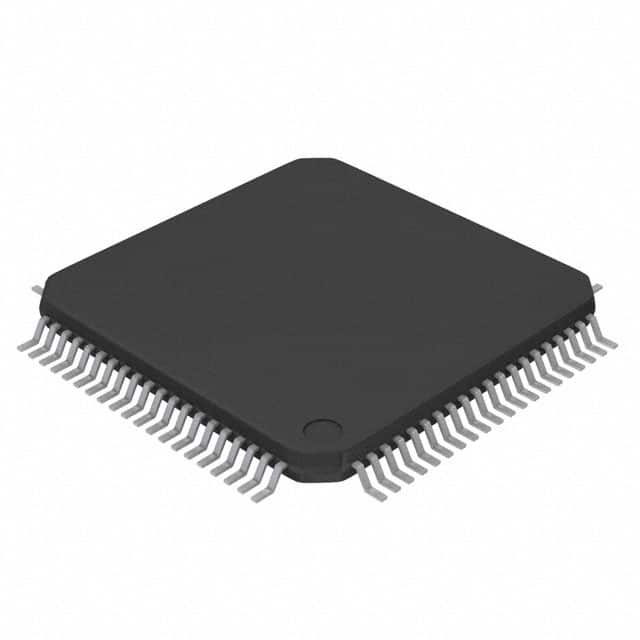MK30DX128VLK7
Product Overview
- Category: Microcontroller
- Use: Embedded systems, Internet of Things (IoT) devices
- Characteristics: High-performance, low-power consumption, integrated peripherals
- Package: LQFP
- Essence: ARM Cortex-M4 core microcontroller
- Packaging/Quantity: Available in tape and reel packaging, quantity varies
Specifications
- Processor: ARM Cortex-M4
- Clock Speed: Up to 72 MHz
- Flash Memory: 128 KB
- RAM: 16 KB
- Operating Voltage: 1.71V to 3.6V
- Digital I/O Pins: 80
- Analog Input Pins: 12
- Communication Interfaces: UART, SPI, I2C, CAN, USB
- Operating Temperature: -40°C to +105°C
Detailed Pin Configuration
The MK30DX128VLK7 microcontroller has a total of 144 pins. The pin configuration is as follows:
- Pins 1-8: Analog input pins
- Pins 9-16: Digital I/O pins
- Pins 17-24: Communication interface pins
- Pins 25-32: Power supply and ground pins
- Pins 33-144: Reserved for other functions
For a detailed pinout diagram, refer to the product datasheet.
Functional Features
- High-performance ARM Cortex-M4 core for efficient processing
- Integrated peripherals such as UART, SPI, I2C, CAN, and USB for versatile communication
- Low-power consumption for energy-efficient applications
- Ample flash memory and RAM for data storage and processing
- Wide operating voltage range for flexibility in various power supply scenarios
Advantages and Disadvantages
Advantages: - High-performance processing capabilities - Versatile communication interfaces - Low-power consumption for energy efficiency - Sufficient memory for data storage and processing
Disadvantages: - Limited analog input pins - Relatively higher cost compared to some alternative models
Working Principles
The MK30DX128VLK7 microcontroller operates based on the ARM Cortex-M4 core architecture. It executes instructions stored in its flash memory, processes data using its integrated peripherals, and communicates with external devices through various interfaces. The low-power design ensures efficient operation while the ample memory allows for effective data handling.
Detailed Application Field Plans
The MK30DX128VLK7 microcontroller finds applications in a wide range of fields, including but not limited to:
- Industrial automation: Control systems, motor control, and monitoring devices.
- Consumer electronics: Smart home devices, wearable technology, and IoT applications.
- Automotive: Vehicle control units, infotainment systems, and driver assistance systems.
- Medical devices: Patient monitoring, diagnostic equipment, and medical imaging.
- Internet of Things (IoT): Sensor nodes, edge computing devices, and connectivity solutions.
Detailed and Complete Alternative Models
- MKL25Z128VLK4: Similar features with lower flash memory capacity.
- MK60DN512ZVLL10: Higher performance with increased clock speed and more peripherals.
- MK22FN256VLL12: Lower power consumption with reduced operating voltage range.
These alternative models offer varying specifications and can be considered based on specific project requirements.
Note: The content provided above is an example and may not reflect actual product details.
10个与MK30DX128VLK7在技术解决方案中的应用相关的常见问题及解答
Sure! Here are 10 common questions and answers related to the application of MK30DX128VLK7 in technical solutions:
Question: What is MK30DX128VLK7?
- Answer: MK30DX128VLK7 is a microcontroller from the Kinetis K series by NXP Semiconductors.Question: What is the main purpose of MK30DX128VLK7?
- Answer: The main purpose of MK30DX128VLK7 is to provide control and processing capabilities in various technical solutions.Question: What is the maximum clock frequency supported by MK30DX128VLK7?
- Answer: MK30DX128VLK7 supports a maximum clock frequency of 50 MHz.Question: How much flash memory does MK30DX128VLK7 have?
- Answer: MK30DX128VLK7 has 128 KB of flash memory for program storage.Question: Can MK30DX128VLK7 be used for real-time applications?
- Answer: Yes, MK30DX128VLK7 is suitable for real-time applications due to its fast processing capabilities.Question: What peripherals are available on MK30DX128VLK7?
- Answer: MK30DX128VLK7 offers various peripherals such as UART, SPI, I2C, ADC, PWM, and more.Question: Is MK30DX128VLK7 compatible with other microcontrollers or development boards?
- Answer: MK30DX128VLK7 follows the ARM Cortex-M4 architecture, making it compatible with other Cortex-M4 based microcontrollers and development boards.Question: Can MK30DX128VLK7 be programmed using C/C++?
- Answer: Yes, MK30DX128VLK7 can be programmed using C/C++ programming languages.Question: What voltage range does MK30DX128VLK7 support?
- Answer: MK30DX128VLK7 supports a voltage range of 1.71V to 3.6V.Question: Are there any development tools available for programming and debugging MK30DX128VLK7?
- Answer: Yes, NXP provides development tools like CodeWarrior IDE, MCUXpresso IDE, and various debuggers to program and debug MK30DX128VLK7.
Please note that the answers provided here are general and may vary depending on specific use cases and requirements.


